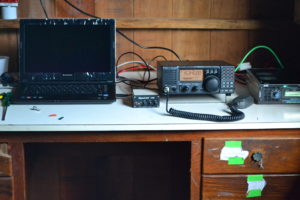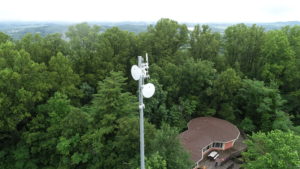$1.6 Million to Connect Unconnected Americans: Our NSF-WINS Grand Prize Winners
Today, Mozilla and the National Science Foundation (NSF) are announcing the grand prize winners in our Wireless Innovation for a Networked Society (NSF-WINS) Challenges - an audacious competition to connect millions of unconnected Americans.
The grand prize winners are as novel as they are promising: An 80-foot tower in rural Appalachia that beams broadband connectivity to residents. And, an autonomous network that fits in two suitcases - and can be deployed after earthquakes and hurricanes.
Says Mark Surman, Mozilla's Executive Director: "We launched NSF-WINS in early 2017 with the goal of bringing internet connectivity to rural areas, disaster-struck regions, and other offline or under-connected places. Currently, some 34 million Americans lack high-quality internet access. That means 34 million Americans are at a severe economic, educational, and social disadvantage."
"Now - after months of prototyping and judging - Mozilla and NSF are awarding $1.6 million to the most promising projects in the competition's two categories. It's part of Mozilla's mission to keep the internet open and accessible, and to empower the people on the front lines of that work."
Says Jim Kurose, head of the Directorate for Computer and Information Science and Engineering (CISE) at the NSF: "By investing in affordable, scalable solutions like these, we can unlock opportunity for millions of Americans."
The NSF-WINS 'Off the Grid Internet Challenge' $400,000 grand prize winner is"
HERMES
HERMES (High-frequency Emergency and Rural Multimedia Exchange System) by Rhizomatica in Philadelphia, PA.
When disasters strike, communications networks are among the first pieces of critical infrastructure to overload or fail.
HERMES bonds together an assortment of unexpected protocols - like GSM and short-wave radio - to fix this. HERMES enables local calling, SMS, and basic OTT messaging, all via equipment that can fit inside two suitcases.
"In an emergency, you want to be able to tell people you're okay," the Rhizomatica team says. "HERMES allows you to tell anyone, anywhere with a phone number that you're okay. And that person can respond to you over text or with a voice message. It also allows someone from a central location to pass information to a disaster site, or to broadcast messages. We can now send a text message 700 miles through HERMES."
The NSF-WINS 'Smart Community Networks Challenge' $400,000 grand prize winner is"
Southern Connected Communities Network
Southern Connected Communities Network (SCCN)by the Highlander Research and Education Center in New Market, TN.
Many communities across the U.S. lack reliable internet access. Sometimes commercial providers don't supply affordable rates; sometimes a particular community is too isolated; sometimes the speed and quality of access is too slow.
SCCN leverages infrastructure and community to fix this and bring broadband to rural Appalachia. SCCN uses an 80-foot tower that draws wireless backbone from Knoxville, TN via the public 11 GHz spectrum. The tower then redistributes this broadband connectivity to local communities using line-of-sight technology. This tower is owned and operated by the local residents.
"When you live in the rural South, your kids' education, your next job, your healthcare, and your right to a political voice all are limited by slow, expensive, unreliable, and corporate-controlled internet connectivity - and that's if it exists at all," says Allyn Maxfield-Steele, Co-Executive Director of the Highlander Center. "So we're claiming internet like the human right it has become. We're building a local digital economy governed by us and for us."
Learn more about Southern Connected Communities Network
~
In addition to these two grand prize winners, Mozilla and the NSF are awarding second-, third-, and fourth-place prizes in each category. The winners are:
Off-the-Grid Internet Challenge:- Second place ($250,000)- Project Lantern by Paper & Equator in New York, NY (and in collaboration with the Shared Reality Lab at McGill University). Project Lantern is a Wi-Fi hotspot device that lets you send maps and messages across town when the internet is down.
- Third place ($100,000)- EmergenCell (previously SELN) by Spencer Sevilla in Seattle, WA. EmergenCell is an off-the-grid and self-contained LTE network in a box for emergency response.
- Fourth place ($50,000)- Wind by the Guardian Project in Valhalla, NY. Wind is a network designed for opportunistic communication and sharing of local knowledge that provides off-grid services for everyday people, using the mobile devices they already have. The project also features decentralized software and a content distribution system.
- Second place ($250,000)- The Equitable Internet Initiative by Allied Media Projects in Detroit, MI. The Equitable Internet Initiative (EII) is an effort to redistribute power, resources, and connectivity in Detroit through community Internet technologies. EII is working toward a future where neighbors are authentically connected, with relationships of mutual aid that sustain the social, economic, and environmental health of neighborhoods.
- Third place ($100,000)- SMARTI (previously Solar Mesh) by the San Antonio Housing Authority in San Antonio, TX. In efforts to bridge the digital divide in San Antonio, the 19th worst connected city in the U.S., the San Antonio Housing Authority has created a prototype that marries solar energy with Wi-Fi mesh technologies.
- Fourth place ($50,000)- ESU 5 Homework Hotspot by Educational Service Unit 5 in Beatrice, NE. The ESU 5 Homework Hotspots are TV white space hotspots that help bridge the connectivity gap for students in Rural Nebraska.
Note: In February 2018, Mozilla and the NSF announced the first batch of winners: between $10,000 and $60,000 in grants for 20 promising design concepts. See those winnershere.
The post $1.6 Million to Connect Unconnected Americans: Our NSF-WINS Grand Prize Winners appeared first on The Mozilla Blog.